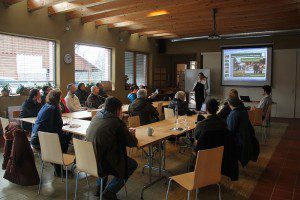Zhůří near Keply, Šumava National Park (CZ) © Štěpán Rosenkranz
 Year of creation: 2015 – The CEE section was previously known as the Czech Republic Section, which expanded, involving currently members from 8 different countries.
Year of creation: 2015 – The CEE section was previously known as the Czech Republic Section, which expanded, involving currently members from 8 different countries.
Number of members: 28 in total in Bulgaria (1), Croatia (3), Czech Republic (6), Hungary (6), Poland (6), Romania (1), Slovakia (1), and Slovenia (1)
The core areas of work: capacity building and transboundary cooperation through communication and experience sharing
Official Website: www.europarc.org/europarc-central-and-eastern-europe Social Media: www.facebook.com/europarccee
Contact person: Szilvia Gőri, PhD, Hortobágy National Park, Hungary. Email: goriszilvia at hnp.hu
President: Gabor Szilagyu
About their work
In Europe, biodiversity is affected mostly by intense agriculture and landscape fragmentation. In this context protected areas are valuable, but only islands. One of the main issues for the members of EUROPARC’s Central and Eastern European (CEE) section is maintaining the status of their protected areas in the face of such pressures. Insufficient financial and technical resources in this region mean that it is challenging to sustain or improve the quality of protected areas.
The sections’ members come from seven countries that have different nature protection systems but similar histories. A major challenge for all of these countries is integrating Natura 2000 into the national protected area systems. A lot has been achieved here already, but more still needs to be done. Another key issue for protected areas in this region is finding ways to sustainably finance protected area management which, in the current climate of austerity measures, is a particularly sensitive issue.
The main questions that the CEE section is currently working to answer are: How can we show that what we do is beneficial to the whole of society and that protected area management is worth investing in financially? How can we ensure public and political support for our work? Further, the section is still brand new and is thus still establishing tools which ensure effective communication and cooperation among members. The most efficient approach so far seems to be sharing information and examples at joint events.
Of particular interest is the positive approach of the International Union for the Conservation of Nature’s Green List of Protected Areas (IUCN Green List), an initiative which encourages, measures, celebrates and shares the success of protected area excellence. The section is also very keen to avoid repeating mistakes that have been made in the past. With the Natura 2000 network, for example, a mutually beneficial partnership will be established, which will help members of the section to convince stakeholders that Natura 2000 also brings them benefits.
Latest Activities

Alluvial forest, Fertő-Hanság National Park © Gábor Takács
EUROPARC CEE Members’ Assembly 2017
During the 4th Members’ Assembly, that took place in Csopak, Hungary between 18th-20th April 2018, the new secretariat of the CEE Section took over. The Assembly-session was held on 19th April 2018 in the Park Villa Guest House of Balaton Uplands National Park Directorate in Csopak, Hungary. Read all information here.
Results of the Workshop on “Management of Natura 2000 Sites in Central and Eastern Europe”.
Between 3-5 May 2017, EUROPARC Central and Eastern Europe and the Fertő-Hanság National Park Directorate (Hungary) organised a workshop to review the management of Natura 2000 sites and summarize experiences. Participants came from Czech Republic, Croatia and Hungary, representing their governmental, non-governmental organisations or public body administrations, managing Natura 2000 sites.
Workshop: „Managing invasive plant and animal species in the protected areas of Central and Eastern Europe”
On the 2-6 May, 40 experts from 15 institutions within the EUROPARC Central and Eastern Europe Section gathered in Hungary for an intensive workshop on the management of invasive species. The workshop was host and organised byHortobágy National Park, with the collaboration of the Hungarian Ministry of Agriculture.
Read the full article and download the presentations here.
EUROPARC CEE Members’ Assembly 2016
Issued by Jakub Kašpar, President of EUROPARC CEE
EUROPARC Section Central and Eastern Europe had its second Members Assembly between the 16th-18th March, at Environmental Centre Veronica in Hostetin*, White Carpathians PLA, Czech Republic. 
During the Assembly, Members discussed information from the EUROPARC Federation Council and especially changes planned for next years, in terms of the relationship between Council, main office in Regensburg and Sections, and confirmed that the Central and Eastern European Section is ready to take coordination role in Transboundary Working Group. We have also discussed our objectives and the opportunity for joint projects within our region using especially the INTERREG Programme.
Important to remember that our Hungarian colleagues organise a Section Experts meeting on “Invasive species in protected areas”, which will take place in Hortobágy National Park, in May. Next year there will be a similar practical meeting about forest inventory and remote sensing in nature conservation organized by Sumava National Park, Czech Republic.
The final field excursion to Čertoryje Natural Reserve was a nice final bonus as well as a great guidance by the botanist Ivana Jongepierová from White Carpathians PLA Administration.
Downloads
CEE Members Assembly Minutes and annexes (include the list of participants, programme and project proposal BRICK)
Administrative organisation and Questionnaire on the institutional setup of national parks
*About our host:
The Environmental Centre Veronica in Hostetin is placed in a village which became a model eco-village in all the country on the edge of 1990’s and 2000’s – using reed-bed sewage treatment plant, biomass heating plant or solar thermal and photovoltaic panels on house roofs 10-15 years before all others started to think about such solutions.

EUROPARC CEE Section members assembly 2016 at Environmental Center Veronica, CZ © Jakub Kašpar

EUROPARC CEE Section members assembly 2016 at Environmental Center Veronica, CZ © Jakub Kašpar

Garden of the Environmental Center Veronica, CZ © Jakub Kašpar

Earwig house, Environmental Center Veronica, CZ © Jakub Kašpar